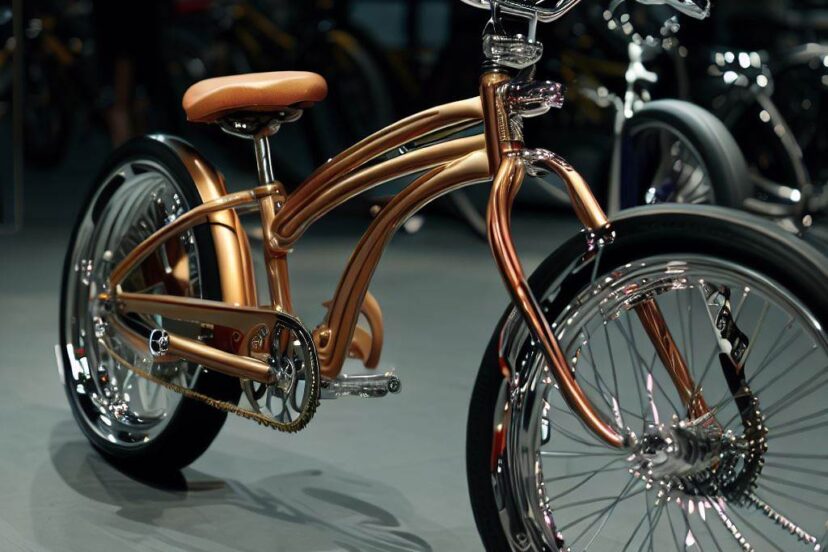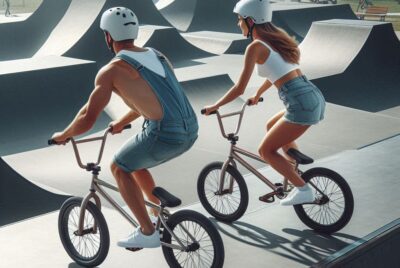Lowrider Bike Magic: Riding in Style with Custom Creativity
*We may earn a commission for purchases made using our links. Please see our disclosure to learn more.
Lowrider Bike Essentials: Upgrading Your Ride with Style
As a cycling enthusiast with a particular interest in unique bike cultures, I’ve come to appreciate the charm and distinctiveness of lowrider bikes. These bikes aren’t just a means of transportation; they’re rolling pieces of art, reflective of a rich history and culture. Rooted in the creative expression of Mexican-American communities, lowriders emerged as a staple of American culture, especially within California where the movement gained significant traction.
The allure of lowrider bikes lies in their ability to convey a rider’s identity and creativity. Historically, these bikes have offered a canvas for personal expression, much like their automotive counterparts. Enthusiasts would invest not just in their bike’s performance but in its appearance as well, adding custom parts such as hydraulics, twisted metal accessories, and personalized handlebars. The customization of a lowrider bike is not just about aesthetics; it’s a deliberate act of solidarity and a nod to the cultural history from which these bikes originate.
While the bikes initially served as a form of artistic and cultural statement, they have since found a broader audience, attracting fans from different backgrounds who resonate with the style and philosophy of the lowrider community. Bike shops such as SGV Bicycles and Fantasy Toys now cater to this growing interest, offering a range of parts and bikes that allow for high levels of customization to create a one-of-a-kind vehicle. This movement’s longevity is a testament to its deep-seated position in the tapestry of American cultural expression.
Design and Customization of a Lowrider Bike
Lowrider bikes offer an expansive canvas for expressing individuality, and every element is an opportunity for personalization. I’ll guide you through the integral aspects of design and customization, ensuring your lowrider bike stands out with style and personality.
Frame and Forks
The frame is the backbone of any lowrider bike. When I customize, I often start with a chopper-style frame or one with intricate patterns to set the tone. Forks are usually extended, giving the bike its iconic lowered stance – it’s this distinctive geometry that will make your bike a true head-turner.
Wheels and Tires
I choose wheels and tires that not only complement the frame in style but also in performance. Over-spoked custom wheels are a staple, often paired with whitewall tires for that classic, bold look. This combination is not just a statement of style but also a mark of a lowrider bike’s culture.
Handlebars and Seating
For handlebars, ape hanger handlebars are my go-to for that classic raised and stylish appearance. As for seating, a banana seat supported by a sissy bar isn’t just about retro aesthetics; it provides comfort and enhances the elongated silhouette of the bike. These features together bring the custom look full circle.
Paint and Aesthetics
Finally, my favorite part – the paintwork and decorative details. I often opt for custom paint jobs that involve vibrant colors and patterns. Chrome accents on handlebars to fenders highlight key features and bring an undeniable shine that catches every eye. These finishes are what differentiate a custom lowrider bike from the rest.
Types of Lowrider Bikes

In exploring the niche yet fascinating world of lowrider bikes, I find that they mesmerize enthusiasts with their distinctive styles and deep-seated culture. With roots in the Mexican-American community, these bicycles have evolved into both classic and modern variations.
Classic Models
The quintessential Classic Lowrider embodies a unique cultural expression—aesthetically mesmerizing and historically rich. This type comes equipped with a long, low frame, often reminiscent of the Schwinn Sting-Ray or the Dragster bicycles of the 1960s. It typically features a banana seat, raised handlebars, and a single-speed drivetrain. The signature look is completed with chrome accents and sometimes include overspoked wheels, a nod to the original muscle bikes.
Further customization often transforms Schwinn and other vintage bases, like Malvern Star or Cruiser, into personalized lowriders. Each bike tells a story, with velvet upholstery or even custom paint jobs enhancing their appeal. The banana seat, paired with a sissy bar, is common, allowing for a relaxed ride and a show-stopping appearance.
Modern Variations
Progressing into the modern era, the lowrider bike scene embraces new brands like Micargi and Bratz, each contributing their twist on the classic design. The modern variations might not always stick to single-speed simplicity. Some are equipped with multiple gears to adapt to diverse riding conditions while still prioritizing style.
In my observation, each type of lowrider bike is a testament to the culture’s adaptability and the riders’ imagination—a blend of reverence for the past and an eager embrace of new trends. Whether opting for a vintage classic or a newer model, the choice reflects a commitment to a hobby that is as much about personality as it is about riding.
Customization Process

The transformation of a standard bicycle into a custom lowrider bike is a journey of uniqueness and craftsmanship. It’s about selecting the right parts and applying customizing techniques that reflect my personal style.
Selection of Parts
When I build a custom lowrider bike, I meticulously choose each component to ensure that the final product is both unique and visually stunning. Frames are foundational, as they determine the overall look and stance of the bike. I prefer frames with intricate designs or custom-built chopper styles that set the bike apart. I navigate through a variety of manufacturers to find custom parts like forks, handlebars, seats, and wheels that complement the frame’s aesthetic. Here’s a list of parts I often consider for modification:
- Frame: Chopper-style or custom-designed
- Handlebars: Mustache, chopper, or twisted
- Wheels: Size and spoke patterns (classic 72-spoke or designer spokes)
- Seat: Velour, leather, or custom-embroidered
- Accessories: Chain steering wheels, sound systems, hydraulics, and lights
Customizing Techniques
Once the parts are selected, it’s time to apply customizing techniques that enhance the bike’s aesthetics and functionality. Painting and chrome plating are common methods I use to add a sleek, mirror-like finish to metal components. I often incorporate engraving for that extra touch of personalization and detail. The use of hydraulics is not just an aesthetic choice but also adds a dynamic element to the bike, allowing me to change its height on the fly. I ensure that modifications such as the addition of fenders or sound systems are not only impressive visually but also practical for the bike’s operation.
Through this process, each custom lowrider bike that I craft is a testament to unique individuality and the high-quality customization that defines the culture.
Lowrider Bike Buying Guide

When venturing to purchase a lowrider bike, which is a popular subset of custom bicycles, I focus on two primary avenues: purchasing pre-made lowriders or building my own. Each choice has its advantages and considerations, such as cost, customization level, and comfort, which I will explore in detail.
Pre-Made Lowrider Bike
Pre-made lowrider bikes offer a convenient entry point. I look for those that provide a balance between price and features. Here’s what I consider:
- Price: Understand the range can vary greatly, from budget-friendly options starting around $300 to highly customized pieces costing upwards of $10,000.
- Custom Features: I search for pre-made lowriders that offer unique design elements, which might include custom paint jobs or specially designed frames like the iconic Schwinn Sting-Ray.
| Factors to Consider | Description |
| Frame Design | I ensure the frame design offers both the unique style and a comfortable ride. |
| Cost Efficiency | I evaluate whether the price aligns with the quality and features offered. |
Building Your Own
For those of us seeking a more personalized touch, building a unique lowrider bike from scratch can be a fulfilling project. Consider the following:
- Customization: I determine what custom elements I need, such as specific frames, wheels, and accessories, to create a lowrider that reflects my personal style.
- Source: I identify reputable sources for components to ensure quality and compatibility.
| Component | Consideration |
| Frame | I look for a frame that allows for an elongated and low profile for that distinctive lowrider aesthetic. |
| Comfort | I select parts that will not only look good but also ensure a comfortable ride. |
Deciding to go with a pre-made model or embarking on the journey of building my own comes down to balancing my desire for customization with my budget and the level of involvement I want in the creation process.
FAQs About Your Lowrider Bike
In this section, I’ll address common inquiries about lowrider bicycles, discussing customization options, cost details, essential parts, purchasing venues, frame characteristics, and maintenance advice.
1. How do you customize a lowrider bicycle?
To customize my lowrider bicycle, I start with the frame which is the canvas for personal expression. A custom paint job, detailed engravings, and adding chrome parts are popular choices. Modifications may include altering the handlebars, wheels, and adding accessories like mirrors or lights.
2. Where can one purchase a lowrider bicycle or its components?
A lowrider bicycle or its components can be purchased at specialty bike shops, through online marketplaces specializing in custom bikes, or at community swap meets. It’s also common to find parts at lowrider events and shows.
3. What distinguishes a lowrider bike frame from other bike frames?
A lowrider bike frame is typically longer and sits lower to the ground compared to standard bike frames, which is key to its unique silhouette and style. These frames are often customized with various paint jobs and decorative elements making them stand out.
4. How to maintain a lowrider bike for optimal performance?
To maintain a lowrider bike, I make sure to regularly clean and polish the chrome and painted parts to keep it looking its best. It’s important to check the tire pressure, brakes, and bearings frequently, and lubricate the chain to ensure a smooth ride. Regular tune-ups by a professional are recommended to maintain optimal performance.




